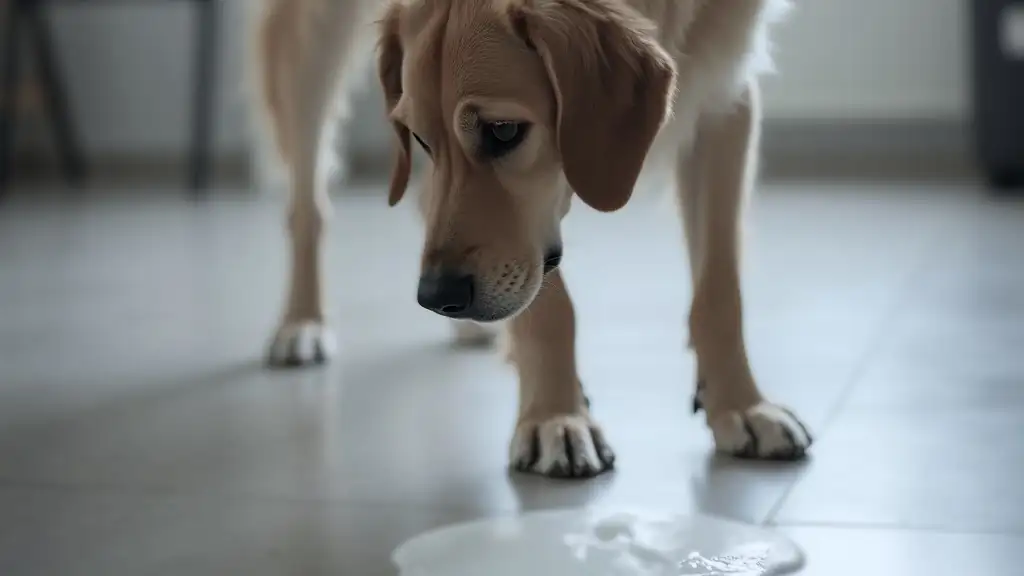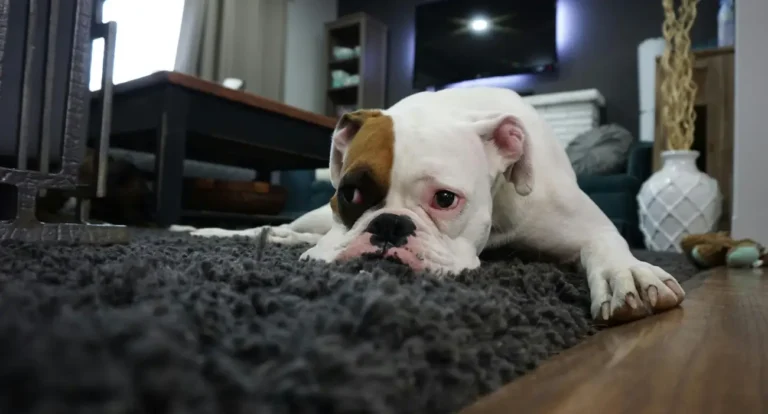Why Is My Dog Vomiting White Foam? 5 Common Causes Explained
Table of Contents
Introuction:
As a pet parent, there’s no greater bond than the one you share with your dog. Whether they’re curled up beside you on a chilly evening or bounding with excitement during playtime, they become an integral part of your life. But when something goes wrong with their health—like vomiting—it can be a deeply unsettling experience. If you’ve recently noticed your dog vomiting white foam, you might be feeling anxious, wondering if it’s something serious or just a temporary issue.
While vomiting is common in dogs, white foam can be a sign that something specific is going on. It’s essential to understand what might be causing this behavior so you can take the right steps to help your dog feel better. This comprehensive guide will walk you through the possible causes of white foam vomiting, when it’s time to seek veterinary care, and how you can manage and prevent it in the future.
What Does It Mean When a Dog Vomits White Foam?
Vomiting white foam might seem alarming, but it’s a symptom with several potential explanations. Before jumping to conclusions, it’s crucial to understand what white foam actually is. In simple terms, white foam is typically a mixture of stomach acid and mucus that has built up in your dog’s stomach. It can occur for a variety of reasons, including when your dog’s stomach is empty, when they are anxious, or when there is a more serious underlying issue like infection or gastrointestinal problems.
The foam itself is generally composed of gas, mucus, and bile, which can accumulate in your dog’s stomach and eventually be expelled in a foamy form. In some cases, it’s just an indication that your dog’s digestive system is a little off. In others, it may be a sign of something more concerning.
But what exactly could cause your dog to vomit white foam? Let’s dive into some of the most common causes.
1. Gastric Irritation or Empty Stomach
One of the most common causes of white foam vomiting in dogs is gastric irritation. This typically happens when your dog’s stomach is empty for an extended period, leading to the accumulation of gastric acids. Without food to absorb these acids, the stomach lining can become irritated, resulting in vomiting. This is most often observed in the early morning hours before your dog has had anything to eat.
If your dog is vomiting white foam in the morning, it could simply be their stomach reacting to the lack of food. This doesn’t necessarily indicate a serious health problem. However, if the vomiting continues or becomes more frequent, it may be worth exploring other potential causes.
Tip: If your dog vomits white foam regularly in the morning, try adjusting their feeding schedule. You might want to provide a small snack before bedtime to help prevent an empty stomach and the irritation that comes with it.
2. Indigestion and Dietary Issues
Dietary issues are another significant factor that can cause dogs to vomit white foam. If your dog is consuming food that doesn’t sit well with their stomach—whether due to a food intolerance, allergies, or simply overeating—it can lead to digestive upset.
In some cases, dogs may eat too quickly or consume something they shouldn’t, like garbage or toxic plants, causing gastrointestinal distress. Overeating can also result in vomiting, as your dog’s stomach may struggle to process large amounts of food at once.
If your dog’s vomiting is linked to a dietary issue, the first step is to evaluate their food. Has there been a sudden change in their diet? Are they eating something new? Identifying and removing the trigger food can often resolve the issue.
List of Common Dietary Triggers:
- Sudden changes in food
- Food allergies or intolerances
- Eating too quickly
- Eating inappropriate items like garbage or plants
3. Bloating and Gastric Torsion (GDV)
Gastric Dilation-Volvulus (GDV), more commonly known as bloat, is a serious condition that requires immediate attention. In GDV, a dog’s stomach fills with gas and twists, causing a buildup of pressure that cuts off blood supply and leads to shock. Vomiting white foam is one of the key symptoms of GDV, alongside a bloated, distended abdomen.
Bloat is a medical emergency, and if your dog shows signs of this condition, you should contact your veterinarian or emergency animal clinic immediately. GDV can be fatal without prompt treatment, so it’s essential to act quickly.
Warning Signs of GDV:
- Abdominal bloating or distension
- Excessive drooling
- Restlessness or discomfort
- Rapid breathing or panting
- Vomiting white foam or trying to vomit without success
4. Infections or Parasites
Infections or parasitic infestations can also lead to vomiting white foam. Bacterial and viral infections, such as parvovirus, can irritate your dog’s stomach and digestive tract, leading to vomiting. Additionally, parasites like roundworms or hookworms can disrupt your dog’s gastrointestinal system, causing discomfort, nausea, and vomiting.
If your dog’s vomiting is accompanied by other signs of illness, such as diarrhea, lethargy, or weight loss, an infection or parasites could be to blame. A trip to the vet for a proper diagnosis and treatment plan is essential in these cases.
Common Parasites Linked to Vomiting:
- Roundworms
- Hookworms
- Giardia
- Coccidia
5. Anxiety and Stress
Believe it or not, your dog’s emotions can have a significant impact on their physical health. Just like humans, dogs can experience stress and anxiety, which can manifest in physical symptoms such as vomiting. Dogs suffering from separation anxiety or stress caused by changes in their environment, such as moving to a new home or traveling, may vomit white foam as a result.
In these situations, the vomiting is often linked to the dog’s emotional state rather than a physical illness. If you suspect anxiety is the culprit, addressing the underlying cause of stress, such as providing a calm environment or seeking professional behavior therapy, can help manage the symptoms.

When Should You Be Concerned About Dog ?
While occasional vomiting of white foam may not be a cause for concern, there are certain situations where you should be vigilant and seek veterinary care. If your dog exhibits any of the following signs along with vomiting, it’s essential to get in touch with your vet as soon as possible:
- Vomiting persists for more than 24 hours
- Vomiting is accompanied by lethargy or weakness
- Blood is present in the vomit
- Your dog is in visible pain or discomfort
- Signs of dehydration, such as dry gums or excessive panting
If you notice any of these signs, it’s crucial to take your dog to the vet for a thorough examination. The longer you wait, the more complicated the issue could become, especially if the vomiting is a symptom of a serious condition like GDV, an infection, or poisoning.
What to Do If Your Dog Vomits White Foam?
If your dog vomits white foam, the first step is to stay calm and observe their behavior. Here’s what you should do:
Step 1: Monitor Your Dog’s Symptoms
Keep an eye on your dog’s vomiting frequency and any other symptoms they may be displaying. Is the vomiting a one-time occurrence, or has it happened multiple times? Are there any other signs of illness, such as diarrhea, lethargy, or loss of appetite? The more information you can gather, the easier it will be for your vet to diagnose the issue.
Step 2: Visit the Vet for Diagnosis
If your dog’s vomiting persists or you’re concerned about their health, it’s time to visit the vet. Your vet may perform diagnostic tests such as blood work, ultrasound, or X-rays to determine the underlying cause. Early diagnosis is key to effective treatment, so don’t delay seeking professional help if your dog’s condition worsens.
Prevention and General Care for Dogs with Sensitive Stomachs
If your dog is prone to vomiting white foam, there are several steps you can take to prevent it:
- Stick to a Consistent Feeding Schedule: Feeding your dog at regular intervals can help prevent an empty stomach and the resulting gastric irritation.
- Avoid Sudden Diet Changes: If you need to change your dog’s food, do so gradually to avoid upsetting their digestive system.
- Manage Stress: Providing a calm environment and addressing anxiety issues can reduce stress-induced vomiting.
- Monitor Eating Habits: If your dog eats too quickly, consider using a slow-feed bowl to help them eat at a more controlled pace.
Frequently Asked Questions (FAQ)
Why Is My Dog Vomiting White Foam in the Morning?
If your dog is vomiting white foam in the morning, it’s likely due to an empty stomach. Gastric acids build up overnight, leading to irritation and vomiting. You can try feeding your dog a small meal before bedtime to prevent this from happening.
How Can I Stop My Dog from Vomiting White Foam?
To stop your dog from vomiting white foam, consider adjusting their diet, reducing stress, and providing regular meals to prevent an empty stomach. If vomiting persists, consult with your vet for further guidance.
Is It Normal for a Dog to Vomit White Foam Occasionally?
Occasional vomiting of white foam is generally not a cause for concern, especially if it occurs after your dog’s stomach is empty. However, if it becomes frequent or is accompanied by other concerning symptoms, it’s important to seek veterinary advice.
Should I Rush to the Vet If My Dog Is Vomiting White Foam?
If your dog is vomiting white foam occasionally, and they are otherwise behaving normally, it may not require immediate attention. However, if the vomiting is persistent, accompanied by other signs of illness, or if your dog is showing signs of distress, you should consult your vet as soon as possible.
Conclusion: Ensuring Your Dog’s Health and Well-Being
Vomiting white foam can be alarming, but in many cases, it’s simply a sign that something is irritating your dog’s stomach or digestive system. By understanding the potential causes of this symptom, you can take steps to address the issue and ensure your dog’s well-being.
If the vomiting persists or worsens, it’s important to seek professional veterinary care to rule out any serious conditions. Your dog depends on you for love and care, and with the right attention, they’ll be back to their playful, happy self in no time.
Take action now—monitor your dog’s health, make any necessary adjustments, and reach out to your vet if needed. Your dog’s health is worth the extra care and attention.






